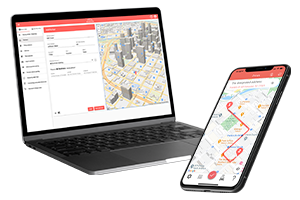Last updated on: October 24, 2023
If you’re a business owner or self-employed individual who uses your personal vehicle for work purposes, keeping an accurate record of your mileage is crucial. Not only can such current mileage management systems help you maximize your tax deductions, but they can also provide an added layer of protection in case of an audit.
And while there are numerous cutting-edge distance reporting tools for keeping track of your miles, IRS publication 463 recommends keeping a contemporaneous mileage log.
However, what happens if you didn’t record all of your miles?
This is where retrospective mileage logs come into the picture. According to IRS publication 463, you can use the method of sampling to create a mileage log that is IRS-Proof.
In this article, we’ll explore the difference between contemporaneous and retrospective logs, as well as how MileageWise’s retrospective mileage log recovery function works and why a retrospective log can still be considered contemporaneous.
What is a contemporaneous mileage log?
A contemporaneous mileage log is a record of all business-related trips made at or close to the time of the trip. This means that the log can be manually written into either
- a paper mileage logbook,
- entered into an Excel or Google spreadsheet,
- tracked via Google Maps Timeline,
- Waze,
- a built-in vehicle GPS system,
- other 3rd-party GPS-based mileage tracking solutions,
- or innovative mileage logbook apps like MileageWise.
Contemporary mileage recordkeeping specifies that the log should provide the date, starting and ending locations, trip purpose, and the total number of miles driven for business purposes.
Any of these methods are still deemed contemporaneous because they were originally recorded at or near the time of your trip by on-the-go odometer documentation and a contemporaneous mileage log is considered valid even if it’s created after the fact, as long as it accurately reflects the trips you took for business purposes.
This implies that if you forget to record a few trips, you can still add them to your log as long as you do so as quickly as possible.
How often should I record my mileage?
Importantly, modern trip distance documentation should be maintained routinely and precisely.
This implies that you should record your mileage on a daily or weekly basis with instant mileage logging tools, as opposed to creating a log at the end of the year. In addition, receipts, bills, and invoices should be included in the log as supporting documentation.
What does “sampling” mean in mileage logging?
According to the IRS Publication 463, you can keep an adequate mileage log with a piece of simultaneous mile tracking software for just a portion of the year and use that to prove the amount of business or investment use for the whole year; a term classified as sampling.
Therefore, by creating a contemporaneous mileage log for a period of three months, and applying the sampling rule, you may use the data collected to prepare a retrospective log, rendering the log for the entire year contemporaneous.
You must demonstrate by other evidence that the periods for which a retrospective mileage log is kept are representative of the use throughout the tax year.
Additionally, you must keep track of the total miles driven during the tax year and the total business miles driven, as well as any adjustments made for the personal use of a vehicle.

How does MileageWise help me with my retrospective mileage log?
MileageWise offers a unique retrospective mileage log recovery feature that uses advanced algorithms and data analytics to analyze your driving patterns and generates a mileage log based on your historical driving data, which you can accept, edit, or refuse (in the latter case, MileageWise’s AI Wizard function will give you a new set of recommendations for your forgotten trips and miles).
The system will also identify which trips were business-related and which were personal, and assign the appropriate mileage deductions accordingly. If there are any gaps in your historical driving data, you can manually enter trip details or use MileageWise’s AI Wizard function, discussed in the linked article, to fill in those gaps and ensure that your retrospective mileage log is IRS-Proof.
The key takeaways
In conclusion, both retrospective and efficient contemporaneous mileage logs can be considered contemporaneous as long as they are supported by enough evidence and show the taxpayer’s actual mileage use throughout the year. It is important for taxpayers to keep accurate and detailed mileage logs, both to make sure they are following IRS rules and to get the most tax deductions possible.
With real-time mileage tracker solutions like MileageWise that are easy to use, it has never been simpler to keep track of your mileage. Whether you choose a retrospective or a contemporaneous log, you can be sure that you are properly keeping track of your mileage minimizing your tax liability, and ensuring your mileage log is IRS-proof.
So start keeping track of your mileage right away and enjoy the peace of mind that comes with having accurate and up-to-date records that provide an additional safeguard against audits.



